#camillepissaro

And so the binding was complete! I used a spare piece of the endpapers to create a title for the box. The words were pierced out using a scalpel and backed with gold leaf. The title was then sewn to the lid of the box through small holes drilled around the outside of the label.

I knew early on that wanted the container to be made from Maple wood to tie in with the book title and I was pleased to be able to source some. The inside of the box was lined with felt, with a ribbon lifter attached to help to get the book out of the box.
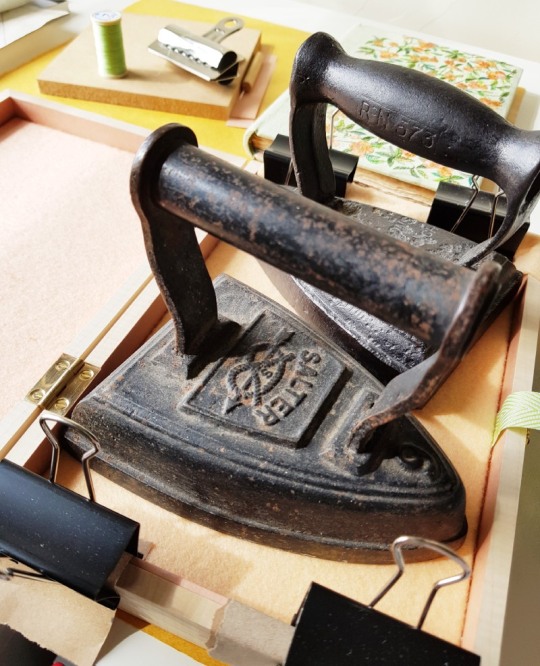
THE COMPLETED BOX

THE BOOK IN THE OPEN BOX
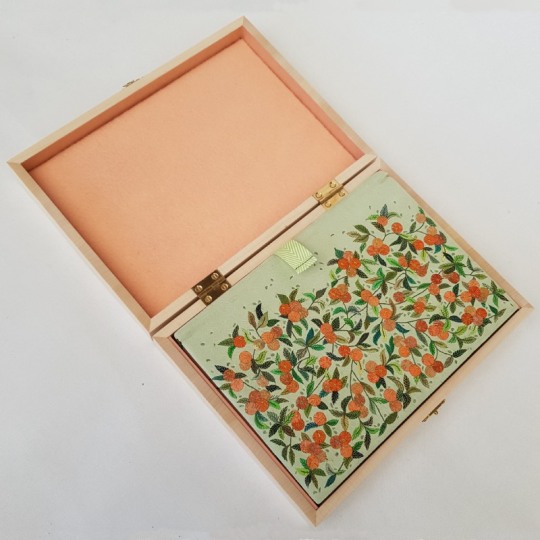
THE BOOK ON THE OPEN BOX

THE BOOK NEXT TO THE BOX
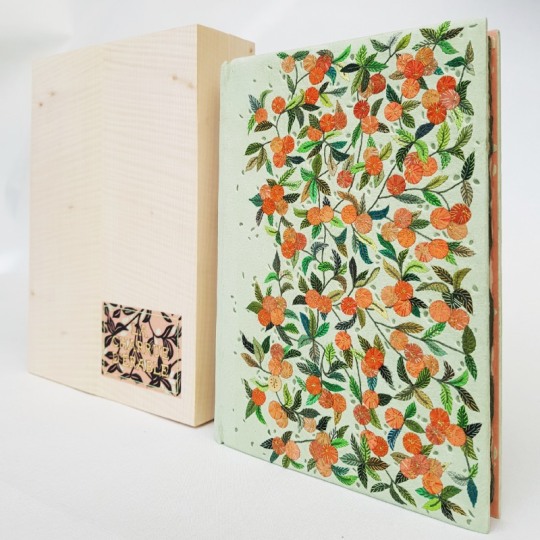
THE EDGE DECORATION
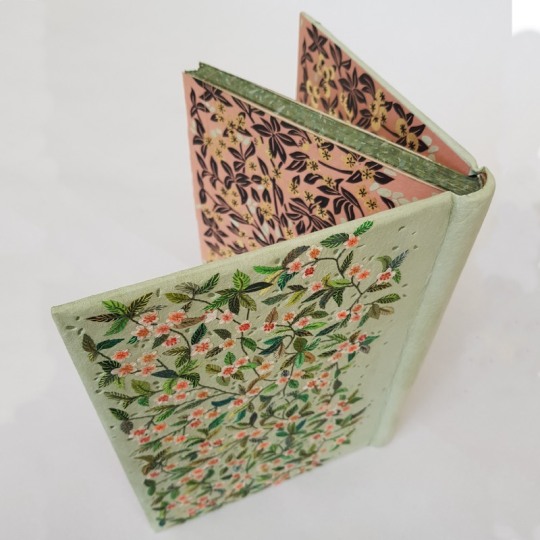
THE FULL COVER

THE PASTE-DOWNS

BACK COVER DETAIL

FRONT COVER DETAIL
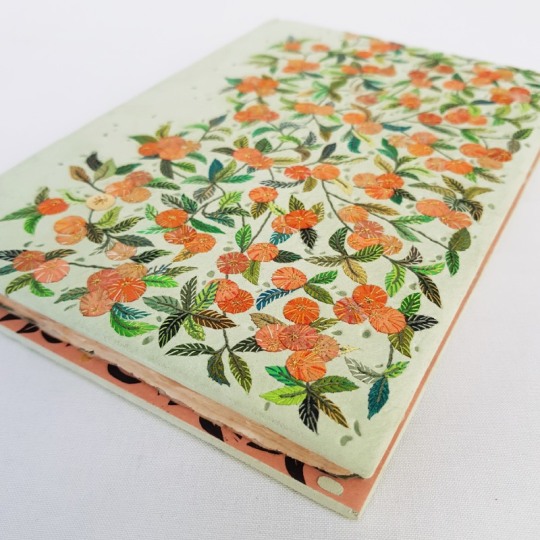
THE ENDPAPERS

I was finally able to order the outer conservation box from The Bodleian Library a few weeks ago.
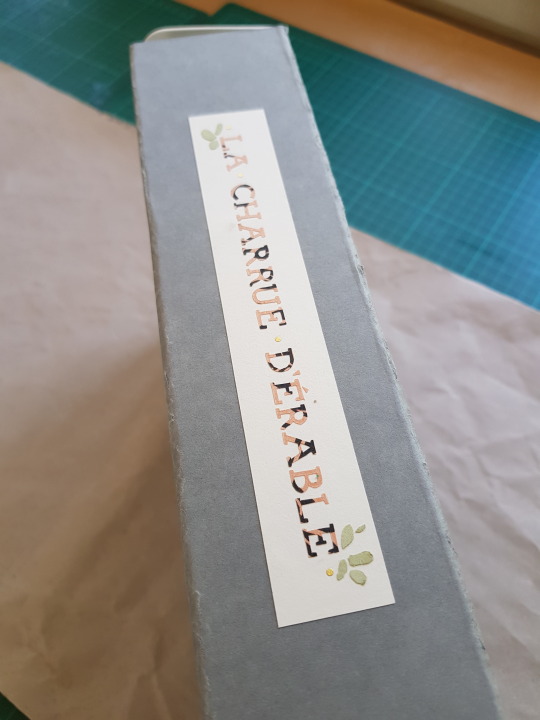
As well as adding a title to the spine, I glued into the inner lid of the box a map dating from 1910, showing the area of “St. Denis-Pontoise” in France, including the town of “Eragny”.

The press was named after the Pissarro family’s home village in Normandy, I will have to try and visit it someday!


Finally the time had come for me to do the bit that I like the most - decorating the covering leather! The first step in the process was to cut out all of the leather onlays I needed to complete the design, including lots of lots of little leaves. On a couple of occasions I brushed past these loose leaves sitting on one of my benches and dislodged a few and it was a rather frustrating game trying to find their correct positions again!
When it came to the apples, I cut out a multitude of discs in different tones of leather and tried to spread the colours out as evenly as possible over the front cover.
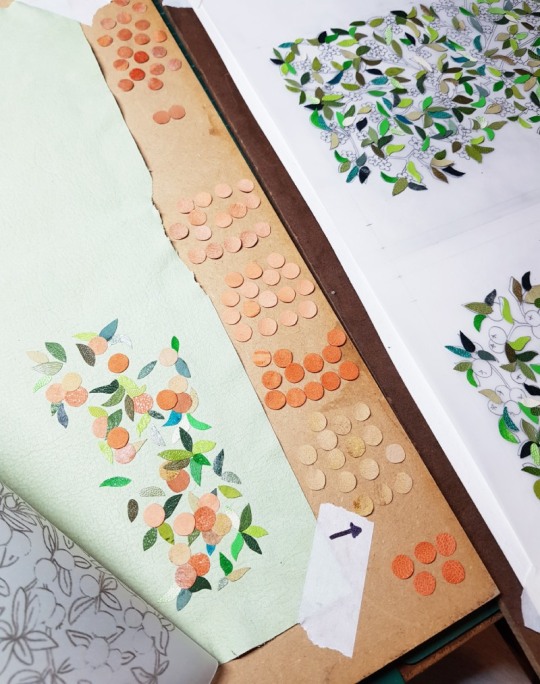
Once all of the onlays were down, I went through my box of threads and pulled out a selection of greens, reds and oranges with which to start sewing the detail onto the cover.

Firstly I concentrated on sewing all of the ‘branches’ using a dark green thread. This also helped to secure each of the leaves onto the leather. Each leaf in turn was then further embroidered with little stitches all the way up in a contrasting green to the colour of the onlay. As the leaves on the front and back covers were mirror images of each other, I made sure to sew the corresponding leaves in the same coloured thread.

The apple blossom was attached to the leather using a double criss-cross stitch to look like the stamens of the flowers. I pricked the holes first with a needle pricker as the vellum inlays were tough to push a needle through.

Onto the end of each of the criss-cross stitched (eight in total for each flower) I tied a small French knot. These were done in a variety of different coloured threads to add variety.

The apples on the front cover were also embellished with a variety of coloured threads, enhancing the colour whilst also securing the onlays down.
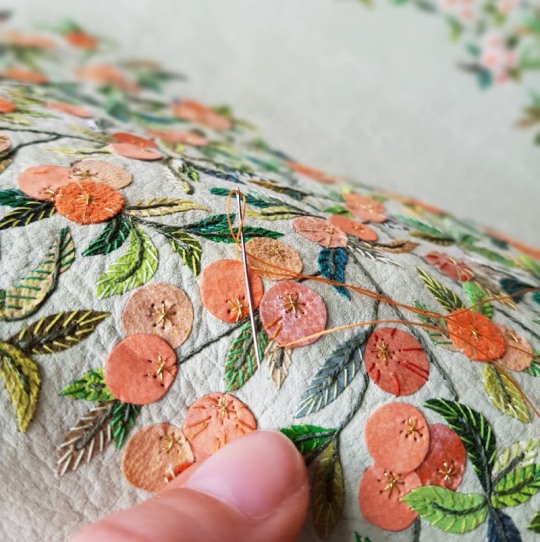
The back of the leather looked like this once the embroidery was complete - a random scattering of coloured threads!

So, the time had come to cover the book, always a daunting task after spending so much time embroidering the leather beforehand. I laid a few layers of newsprint down onto my bench and got together all the tools I needed for the process: sharp scissors, teflon folder, scalpel, fine metal tools for forming the head caps and some cord, also for forming the head caps.

The front of the leather was spritzed with some water to prevent marks from forming on the front of the leather once it dried. The back was pasted out three times using flour paste, with time left in between each application to allow for it to absorb into the leather.

The covering of the binding requires all the hands and nerves I have so I often don’t get many photos of this part of the process! The leather went down well and the book was left to dry under weights between blotting paper for 24 hours, with the blotters changed regularly. The following day, I dampened the joints with a water pen and carefully opened up the boards. The leather joints were stuck down into position with PVA whilst both of the book boards were open.
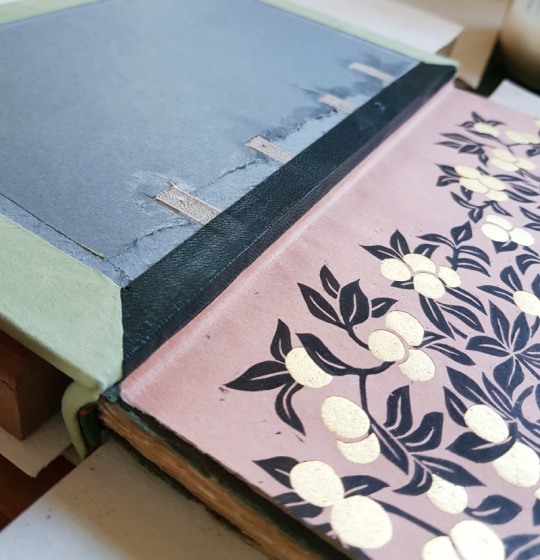
I bought some 18 carat yellow gold sheet in order to add one gold apple to the front cover. This was pierced into shape using a jeweller’s piercing saw and holes drilled through it. One of the criss-crosses was sewn with metallic gold thread, the other had gold wire passed across it to physically attach the gold apple to the book board through small holes that had been drilled using my Dremel..
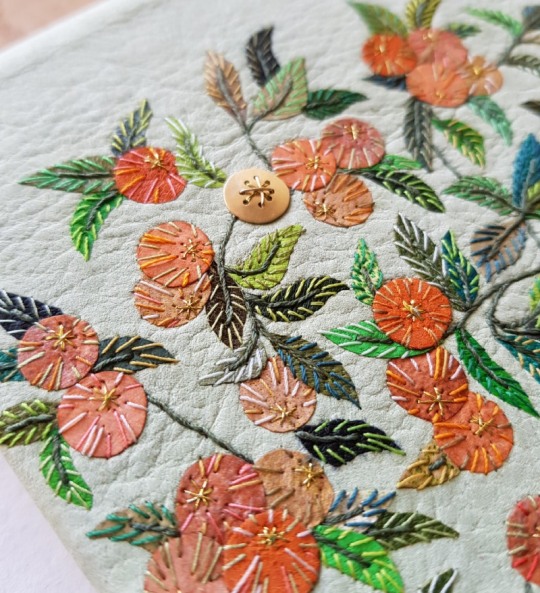
Small channels were cut out of the reverse of the board and the ends of the gold wire were bent into these to permanently fix the gold apple in its place. The insides of both the front and back boards were then infilled and sanded. The first layer was some watercolour paper, which was the same thickness as the turn-ins and the leather joint. The second layer was a piece or Zerkall, cut a few millimetres smaller than the size of the boards. This was then sanded completely flush to get rid of any lumps and bumps.
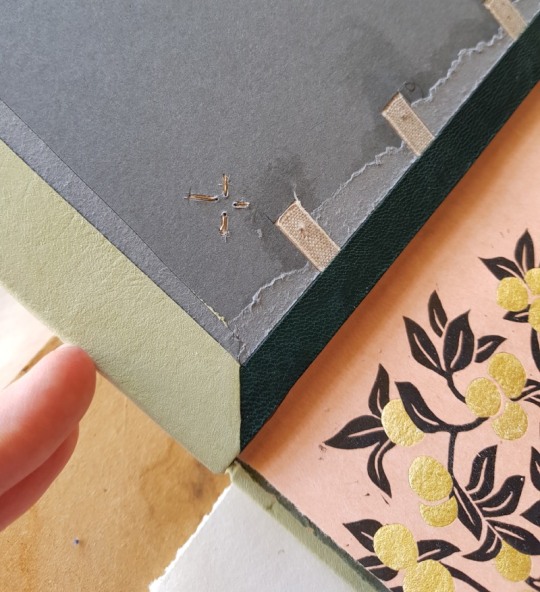
It was then time to stick the paper doublure down to the front and back boards. All of the pierced shapes had been filled with gold leaf backed onto Japanese tissue.

Once stuck down, I wanted to add extra detail to the endpapers and doublures. For the apples inside the front board, I cut out tiny criss-crosses from black paper.

These were then stuck down onto the gold using PVA glue.

For the blossom inside the back board, I used black acrylic paint on the end of a needle pricker and applied paint to each of the flower centres.

Finally, I wanted to add a little of the cover leather to the endpapers and doublures. I cut out small shapes from thinly pared cover leather and stuck them randomly amongst the branches.
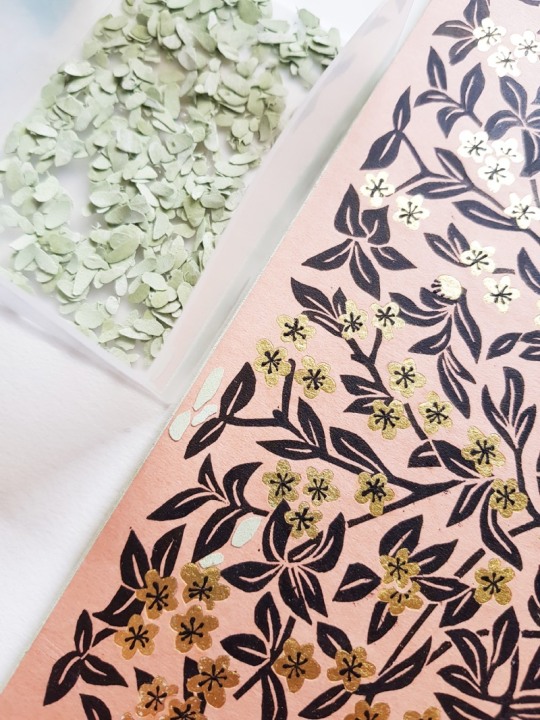
The next, and final, blog post in this series shows images of the completed binding and wooden box that was made for the binding.

The client wished to retain the gilt calf paste-downs if possible to include them within the new binding. To do so it meant removing them from the existing limp cover so I could mount them to new sheets of paper.

The leather of the limp calf cover had started to degrade, so I removed it by peeling it back carefully from the reverse of the paste-down. I was then able to sand the surface using a fine sandpaper.
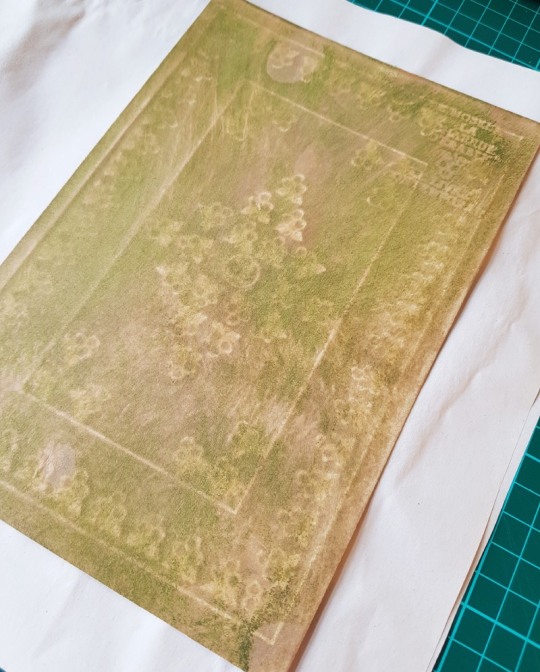
Once sanded the paste-downs were mounted to a bi-folded sheet of paper and sewn to the textblock as an additional section on the front and the back. I wrapped a bi-folded strip of paper to this new section as a guard, the other side of which (as visible in the below photograph) was then tipped onto the endpaper section once that had been sewn to the textblock.

The sections were all then sewn together onto four tapes.
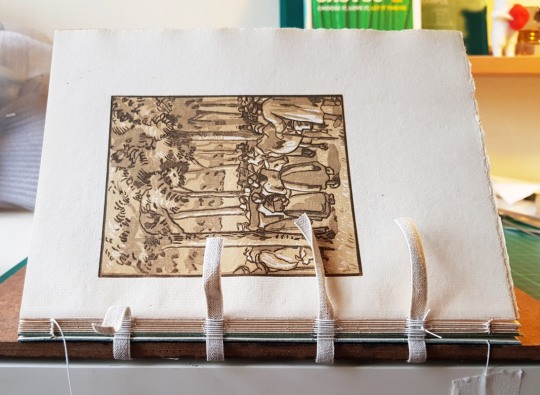
Once all the sections were sewn together, with the endpapers added on at either end, the spine of the book was glued up in-between the tapes with PVA glue and left to dry.

I then rounded and backed the book, and lined the spine attaching a one-on, two-off hollow and then sanded the top edge flush. I wanted to add some edge decoration and did so using watered down acrylic paints. I first applied a thin layer of dark green to match the paper I had used to mount the new paste-downs onto. I further built up the colour by dabbing on small amounts of white, peach and green paints on top to create an abstract pattern in colours to match the binding.
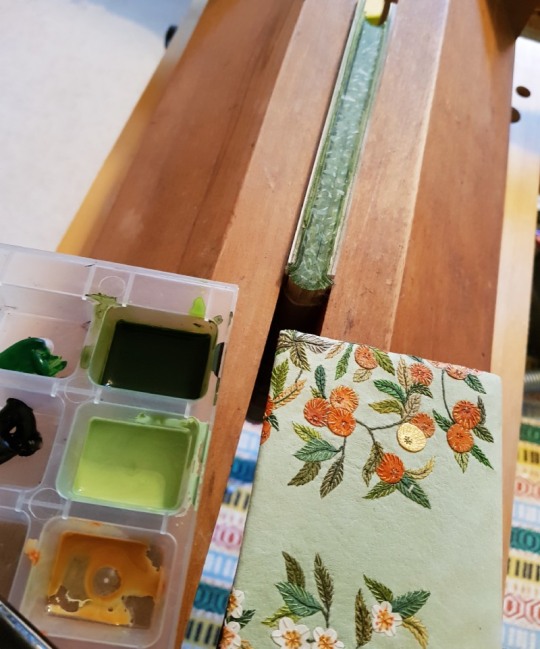
The foredge and bottom edge were left deckled so I did not need to apply edge decoration to them. The next stage was then to sew the endbands. I selected colours that I thought would work well on the binding.

I then created double core endbands using a mixture of these coloured endband threads. The larger core was made from a lamination of leather and a thin strip of vellum. The vellum side was paced pointing towards the top edge of the binding to try and keep a crisp edge where the endband silks wrapped over it. The smaller core was made by stiffening some linen sewing thread with PVA glue and letting it dry out.

The boards were then laced on and bevelled. The covering leather was pared in preparation for the next stage of the binding process.

The next post details how the leather onlays and embroiderd elements were added to the covering leather to build up the design.

Throughout the book there were numerous wood cut prints so I decided to try out some lino printing to tie in with this. In order to transfer the design onto the lino for cutting I placed a sheet of carbon paper on top of the lino. On top of that I laid a line drawing of the design and then I traced the lines with a biro in order to leave a mark through the carbon paper on the surface of the lino.
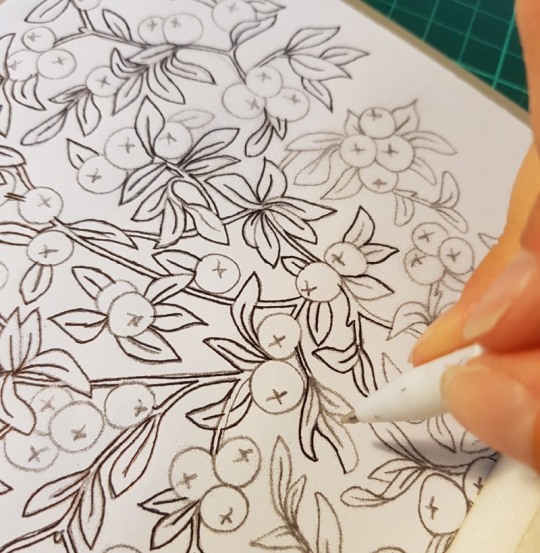
I only wanted to print the leaves using the lino plate, so only marked these areas through the carbon paper. It was very clear to see what I needed to cut once I was done marking the lines.
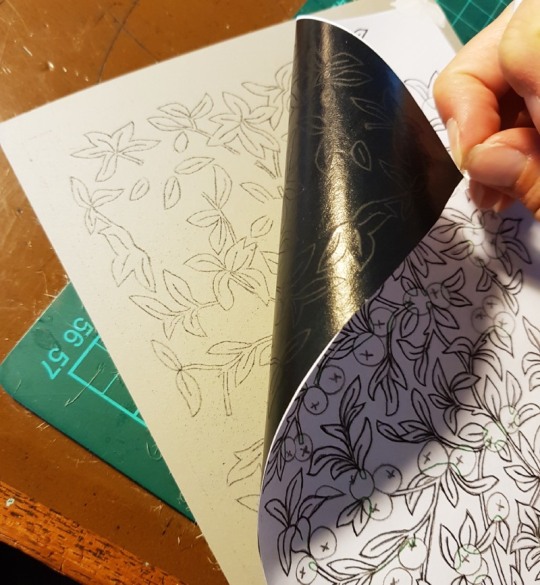
I invested in some rather lovely new “Pfeil” lino cutting tools in a variety of cutting shapes. Each tool is made from chrome vanadium steel with ergonomically shaped hardwood handles – they made slicing the lino a breeze!
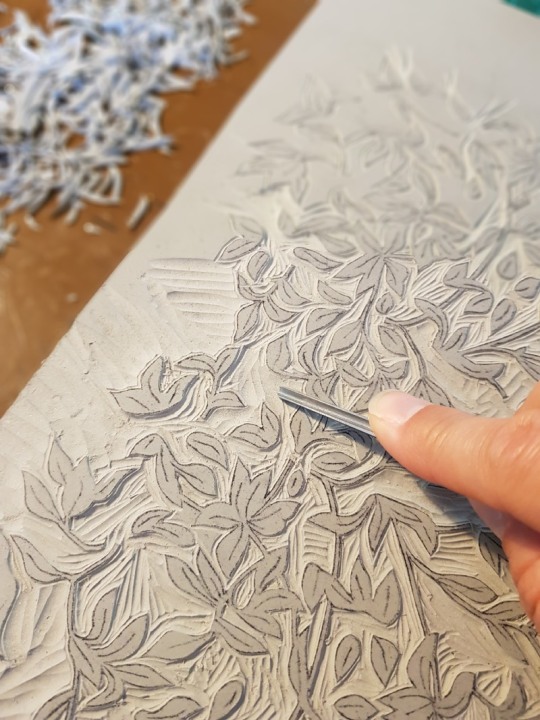
The sample board was done in the same manner, just cut on a smaller scale.

The cut lino was inked up with black intaglio ink using a roller.

The apricot Satogami paper was then laid on top of the lino plate and put into a press. Once printed they were pegged up and left to dry for a few days, I did extra copies so I could select the best ones for the final binding.

I chose to split the cover design so there were apples on the front and apple blossom on the back of the book. I wanted this difference to carry through onto the endpapers and doublures. To add another level of complexity to the design I decided to make it so that each of the flowers and apples on the endpapers and doublures would have gold leaf behind them to catch the light when the book boards were opened which meant cutting out each shape using a scalpel.
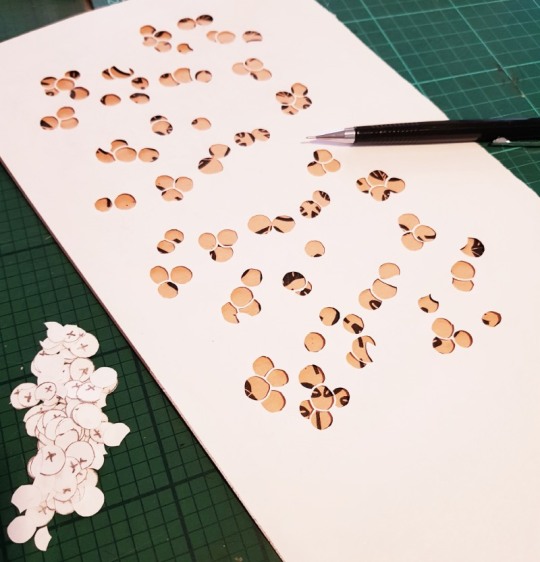
I glued some squares of gold leaf to Japanese paper in preparation using PVA glue and left them to dry.

I flipped both the paper-backed gold leaf and the pierced endpapers over and drew around the shape of the flower and apple clusters that I needed to back onto the reverse side of the gold leaf.
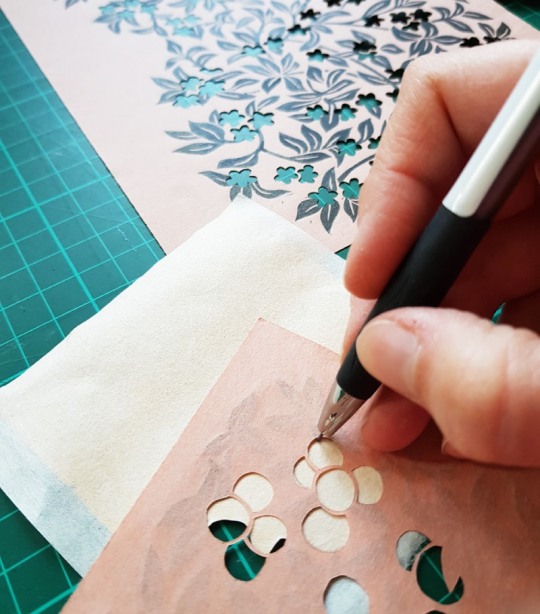
I then made a slightly oversized cut around the pencil outline so that there was enough extra to glue it onto the reverse of the printed paper to span the pierced void.

The next post covers the forwarding of the book!
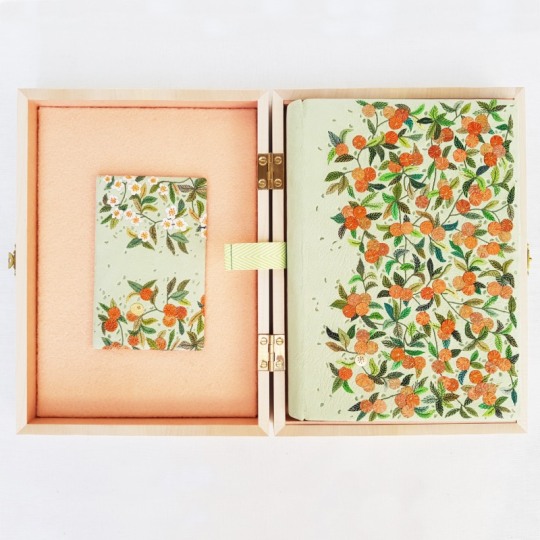
I was shocked to look back at my last blog post to see that it was back in August of 2019, nearly one whole year ago, where did all that time go? I have found it is all too easy to get out of the habit of writing, unless I do so as soon as I have finished a binding or project it seems like a real effort to look back retrospectively and write a post. I have five outstanding things to write about, all of which with photos to edit which seems a bit of a mammoth task!
So, to kick start my blog again I am starting with a binding that I have literally just shipped off to France to a client, I hope it reaches him safely and is well received. In fact the binding itself was finished a couple of months ago but due to the global pandemic I was unable to order an outer conservation box for it, I get these from the University of Oxford, so the binding sat safely in its wooden container in my plan chest until I was able to place an order for a box of the correct size.
The binding is a copy of, “La Charrue D’Érable” (The Maplewood Plough), one of 116 copies printed in 1912 at the Eragny Press in France. The Eragny Press was founded by Lucien Pissarro (1863-1944), the son of the Impressionist, pointillist painter Camille Pissarro. The press was named after the Pissarro family’s home village in Normandy. The Eragny Press specialised in small hand-made books in limited print runs featuring superior coloured wood engravings. The press was active between 1896 and 1914 and produced 32 titles in total, La Charrue D'Érable was the penultimate publication from the press. This is not only the most important book of the Eragny Press, but is also Camille Pissarro’s only substantial illustrated book.
The book is illustrated with twelve full-page, colour wood-engravings drawn by Camille Pissarro and engraved by Lucien Pissarro, primarily printed in shades of peach, green, and/or blue from multiple blocks. In addition, there are numerous wood engraved vignettes, initials, and the title-page border by Lucien Pissarro.

Taken from Via Libri: The World’s Largest Search Engine for Old, Rare and Out-of-Print Books;
“Camille Pissarro exhibited in the first Impressionist show in 1874 and continued his association with the Impressionists for the next dozen years. He then adopted the style of Pointillism briefly, before reverting to an Impressionistic style of landscape painting. It was during this last period of his life that he made the drawings that would eventually result in La Charrue d'Érable. Although the book was not published until 1912, most of the blocks were cut and proofed by Camille before his death in 1903. Lucien Pissarro was trained as a painter by his father, exhibited with the Impressionists, and eventually became interested in book making. After settling in London, he and his wife Esther learned the arts of printing and book design from Charles Ricketts. The early books from Pissarro’s Eragny Press were printed with type supplied by Ricketts. This book is printed in a typeface designed by Lucien Pissarro.”
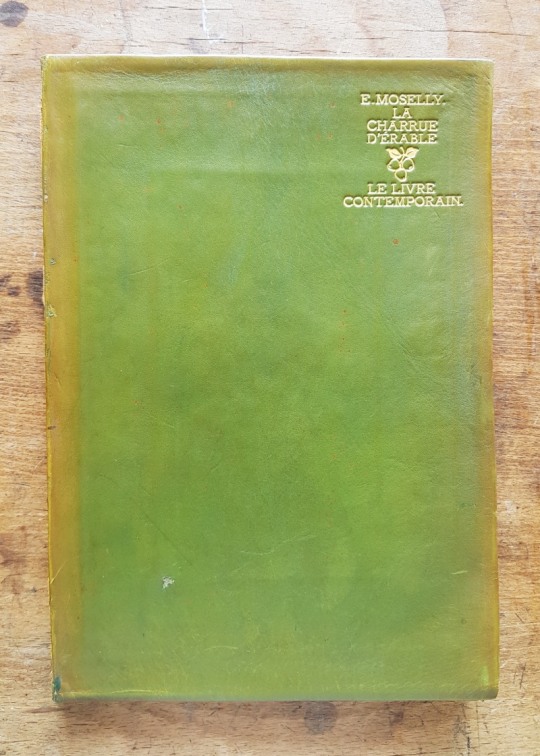
The original book was bound in full limp green calf with gilt titling on the upper cover. The leather had begun to degrade on the copy I was due to rebind, especially on the spine section. There were calf paste-downs inside the limp cover, stamped in gold with apple patterns and a central “Livre Contemporain” monogram. The client was keen to keep these paste-downs in the new binding so I had to think of ways to achieve this. I did also enquire whether he wanted me to try and retain the paper endpapers opposite these leather doublures, they had a sort of ‘halo’ of the leather doublure pattern on them due to the acid from the leather affecting the paper. In the end I though that they were too brittle and damaged to transfer to the new binding.
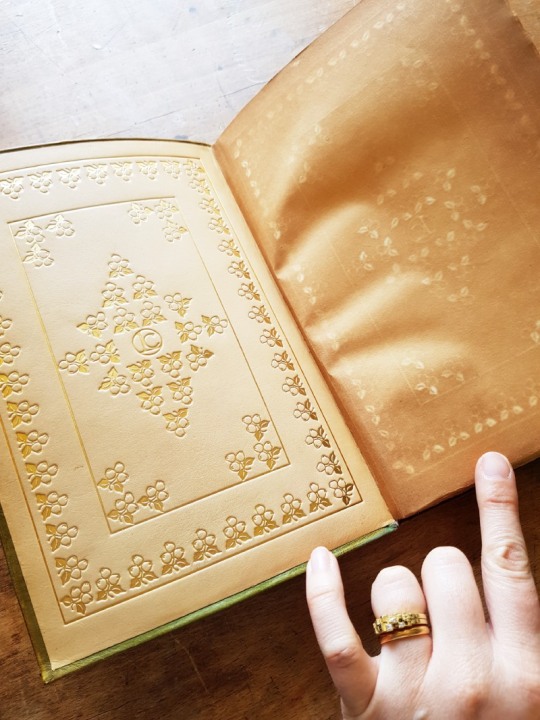
In early 2011 the Ashmolean Museum in Oxford ran an exhibition entitled, “Lucien Pissarro in England: The Eragny Press 1895-1914”, I was able to buy a copy of the catalogue they published online with the same title in order to read up more about the Eragny Press. Lucien was sent to England by his parents where he fell in with a group of artists who were followers of William Morris and the Arts and Crafts Movement. In the 1890s, William Morris founded the Kelmscott Press to produce exquisite, hand-made books. Lucien and his friends wanted to do something similar, and so for the next 20 years he laboured over the spasmodic production of 32 hand-crafted books with his wife, Esther.
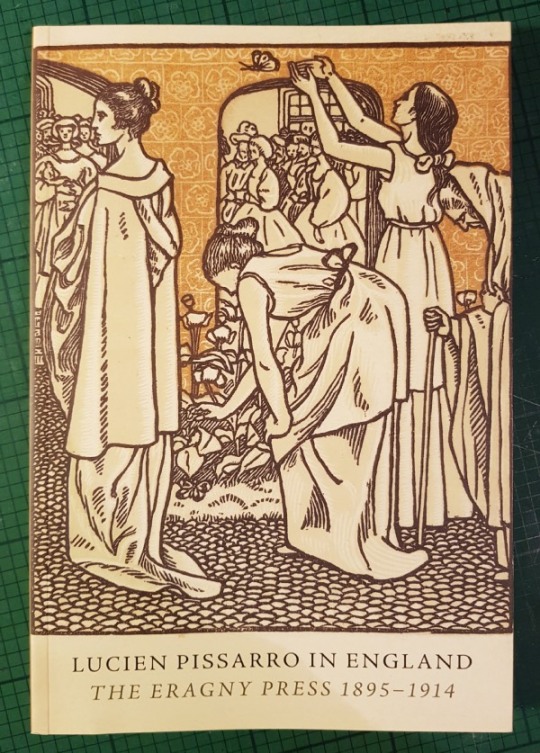
I found it interesting to read that Lucien Pissarro had to wait a long while for the text to be written, it was delayed due to illness and other reasons. He therefore ended up making the initials before the text was written so the writer then had to begin his chapters with words which began with the letters that had been cut!
Although inspired by the Kelmscott Press, the woodcuts are very different to those done by William Morris. There were no floral borders in this text block, although the title page had some floral elements like apples on a tree with one of the chapters actually being called, “Sous Les Pommiers”, or “Under the Apple Tree”. I really liked the way that these branches looked so began to think of ways of incorporating these into the design for the cover.

The book is a quaint representation of rural French farming life. I lived in France for 18 months a few years back although unfortunately I didn’t become a fluent French speaker so I required some help deciphering the, ‘Table des Matières’. I asked a French friend to help me translate the chapter titles which she did, although she was unsure about a couple of them as they were written in old French. Fortunately these gaps were filled by my French-speaking client. Alongside egg and cattle markets (Marché aux œufs/au bétail) and harvesters (Les Moissoneurs) the more interesting descriptions were:
Messidor: During the French revolution, the name of the months were changed. Messidor was the tenth month (from mid June to mid July).
Lavandière Nocturne: A ghostly spirit in the form of a washerwoman doing laundry in the river or pond seen at night. This is a bad omen, usually a herald of death. This is a widespread southern French folk-legend.
La Batterie Mécanique: In this context it is a mechanical thresher for grain.
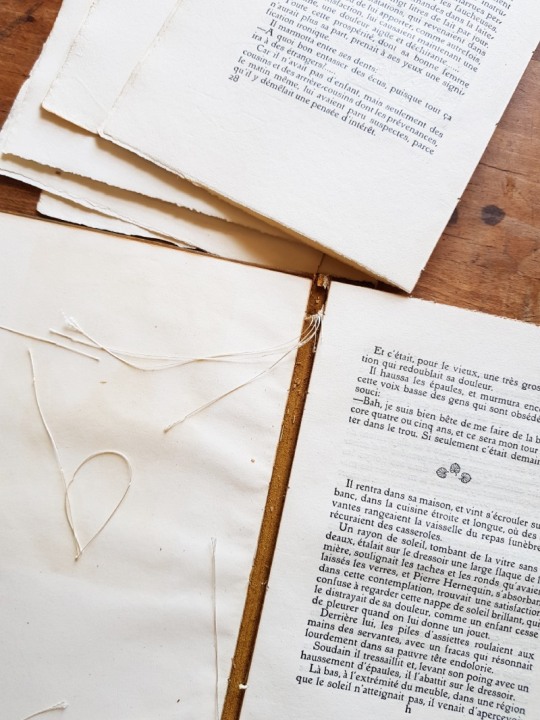
The book was very easy to pull as the covering leather on the spine had degraded and the sewing threads were loose. The central sections therefore pulled away from the leather spine well and I carried out a couple of small repairs on tears using Japanese tissue and wheat starch paste.
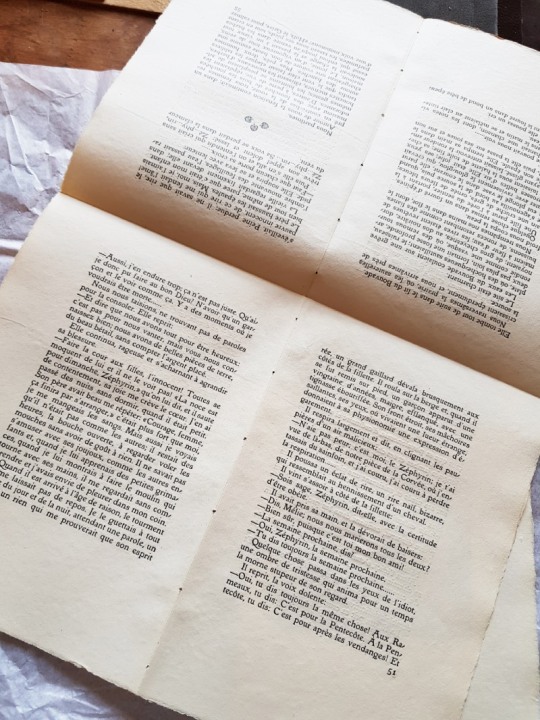
Some of the sections within the text block were unopened, so the top edge of the sections had never been cut meaning that some of the 'hidden’ pages in the original binding would have been hard, if not impossible, to read without tearing the paper.
Many books were sold with unopened pages, this may have been to save the publishers labour and money or to make the sections easier to sew as the pages wouldn’t move around like modern single folio gatherings if left uncut. The reason they were sold like this was that the purchaser/collector was supposed to take the book to a bookbinder of their choice (usually local) who would bind the book according to their personal taste, often the same leather and finishing for each book so that their library looked the same. This was the way books were brought on the market until well into the nineteenth century, until industrial bound books came into being, with their edges cut flush.
The original binding was simple limp calf, perhaps meant as a 'temporary’ binding. Had the edges of the pages been cut, the bookbinder would likely cut them again when rebinding, each time taking more off the text block decreasing it’s size. I made the decision to cut the top edges of the sections in order to make the binding function properly, but left the foredge and bottom edge deckled.
In researching the reason why books were left unopened I was directed to an interesting article entitled, “Uncut, unopened, untrimmed, uh-oh” from The Folger Library about the terminology behind it, having initially referred to the pages of my text block as ‘uncut’ I realise that they should have actually been described as ‘unopened’:
unopened:a book sold with the bolts uncut, to be hand-slit by the purchaser with a paper-knife. It is then said to be opened. Cf. uncut.
uncut:a book is said to be uncut if the edges of the paper have not been cut with the plough or guillotine. Cf. unopened.
The difference between “unopened” and “uncut” is significant for the history of reading: unopened leaves are a pretty good indication that a book wasn’t read when it was new. Uncut leaves, on the other hand, only show that the text block was not neatened up by having the edges trimmed to the same size.

I was inspired by the earthy pastel colours of the woodblock prints. I found a really interesting supplier of Bull skins in a wonderful array of colours, appropriately this was from a French supplier called Remy Carriat. The colour I opted for was a pale green called ‘Pistache’ which was the perfect match for the green on the title page and throughout the binding.
I paired it up with some 80gsm Japanese machine made paper called ‘Satogami’ in the colour Apricot which made the perfect colour palette.
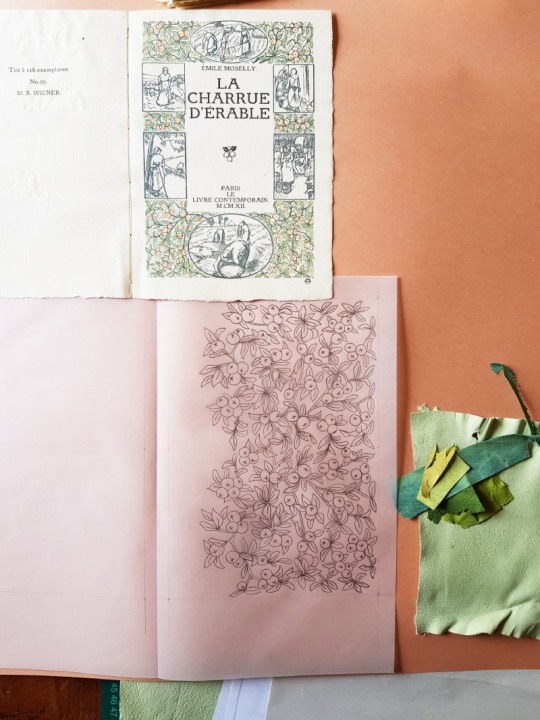
The design was based on a repeat pattern inspired by the apple branches on the title page of the text block.
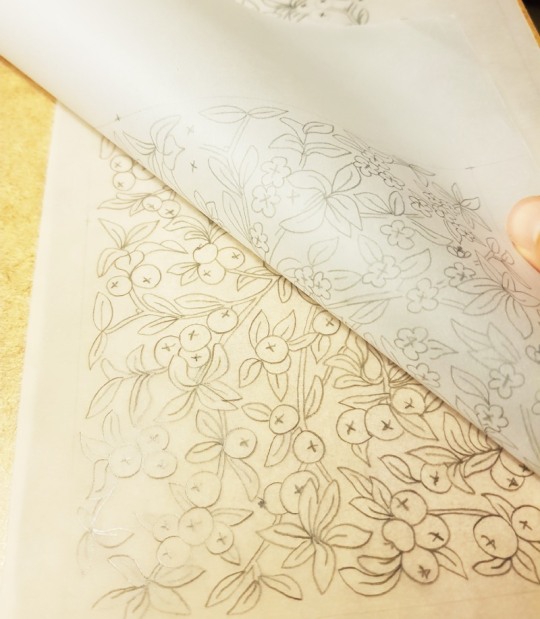
Rather than having apples on the branches over the whole book, I decided to divide the design in two and have apples on the branches one side and apple blossom on the other. I traced the leaf shapes through onto a piece of tracing paper, changing the placement of the apples for flowers for the other half of the binding.

With the colour palette chosen I searched through my bag of leather off-cuts and parings for a variety of pieces to use for the onlays. I chose a selection of greens, oranges and peaches in both leather and suede in order to have a nice selection of different tones on the cover. The suede pieces were backed onto lens tissue to keep them stable.
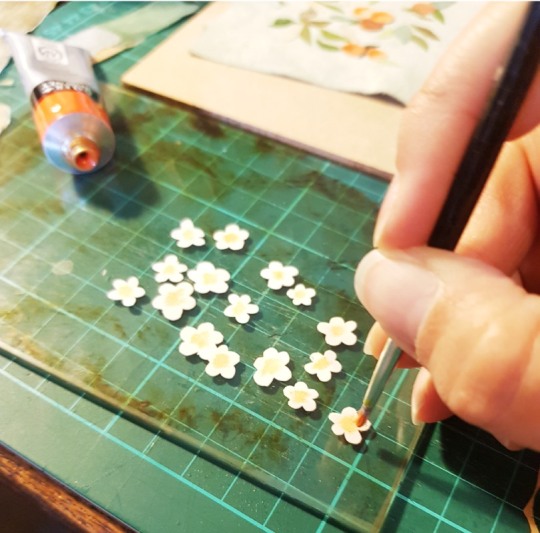
I chose to use thin vellum for the apple blossom, cutting out multiple flower shapes. I then stippled some acrylic paint onto the centres to add some colour.

I first worked on a small piece of leather to make a sample board to test out the design. I make a sample board ahead of each of my fine bindings to test out colour combinations, this one is number 55 in my collection.
A piece of tracing paper with the design on was stuck on top of the pared leather at one side so it could be lifted up and down. The onlays were picked up with fine tweezers, PVA glue applied to the reverse and then they were stuck down in place using the tracing paper template as a guide for placement.
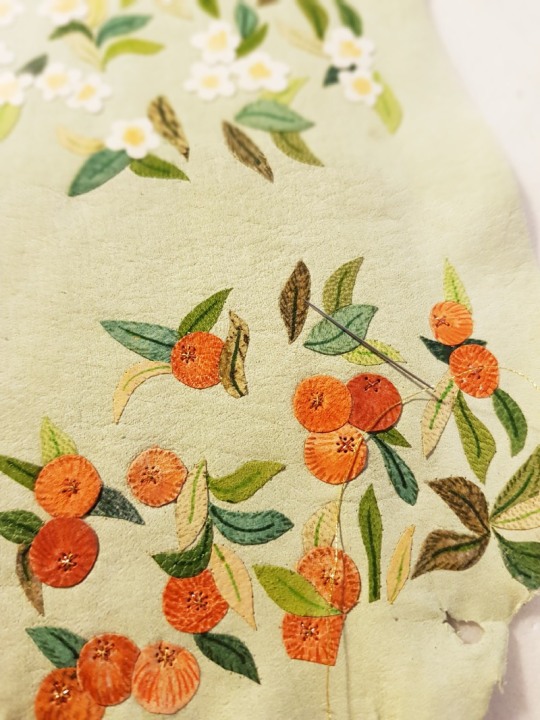
The sample board was then backpared on the reverse before being embroidered.
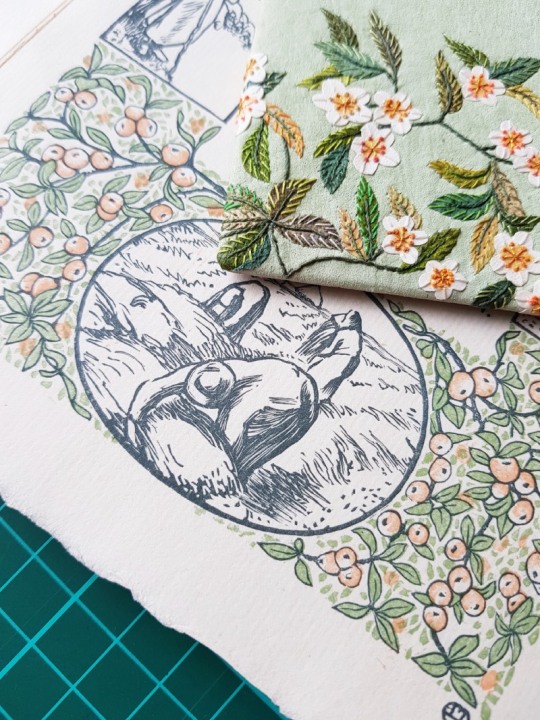
The completed sample board was an excellent match for the title page so I was very pleased.

Jumping ahead, but still on the subject of the sample board, the above picture shows the reverse of the board illustrating the endpapers and the doublures alongside the title page and the paste downs. Please read the next blog post for how the endpapers and doublures were created!
